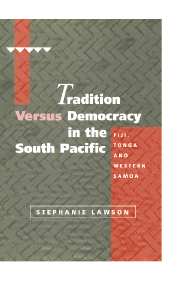Book contents
- Frontmatter
- Contents
- List of Maps
- List of Tables
- Preface
- Epigraph
- The South Pacific
- Introduction
- Chapter 1 Tradition and Democracy
- Chapter 2 Constitutional Development, Chiefly Power and the Politics of Tradition in Fiji
- Chapter 3 The Monarchy Versus Democracy in the Kingdom of Tonga
- Chapter 4 Preserving Tradition Through Democratization: The Introduction of Universal Suffrage in Western Samoa
- Chapter 5 Conclusion: Tradition Versus the West
- Notes
- Bibliography
- Index
Chapter 2 - Constitutional Development, Chiefly Power and the Politics of Tradition in Fiji
Published online by Cambridge University Press: 22 September 2009
- Frontmatter
- Contents
- List of Maps
- List of Tables
- Preface
- Epigraph
- The South Pacific
- Introduction
- Chapter 1 Tradition and Democracy
- Chapter 2 Constitutional Development, Chiefly Power and the Politics of Tradition in Fiji
- Chapter 3 The Monarchy Versus Democracy in the Kingdom of Tonga
- Chapter 4 Preserving Tradition Through Democratization: The Introduction of Universal Suffrage in Western Samoa
- Chapter 5 Conclusion: Tradition Versus the West
- Notes
- Bibliography
- Index
Summary
Introduction
Fiji consists of approximately 320 islands which are scattered over an area of 650,000 square kilometres in the south-west Pacific. About 150 are inhabited. The total land area is just over 18,000 square kilometres, making Fiji one of the largest states in the region. The islands of Viti Levu and Vanua Levu are the two largest land masses in the group and together comprise almost 16,000 square kilometres. Indigenous Fijians are usually described as Melanesian, although there is ample evidence of a long-standing Polynesian presence not only in physical terms, but in some of the most important sociopolitical structures. This is especially so in the eastern regions of Fiji which lie closest to the Tongan and Samoan groups. Fiji is now home to around 700,000 people, just under half of whom are descended from settlers who arrived in successive waves of migration from about 1500 BC, as evidenced by the presence of Lapita pottery fragments in a number of sites which date from this time. Archaeological and linguistic evidence supports the hypothesis that the early Lapita people were the forebears of the Fijians as well as the Polynesians. In Fiji, linguistic research also indicates that there was a break in the dialect chain in the later history of the islands between the western and eastern regions. Routledge has argued that internal historical developments of this kind are more important to the understanding of Fijian society than those which focus on external antecedents and affiliations.
- Type
- Chapter
- Information
- Tradition versus Democracy in the South PacificFiji, Tonga and Western Samoa, pp. 37 - 78Publisher: Cambridge University PressPrint publication year: 1996
- 1
- Cited by



